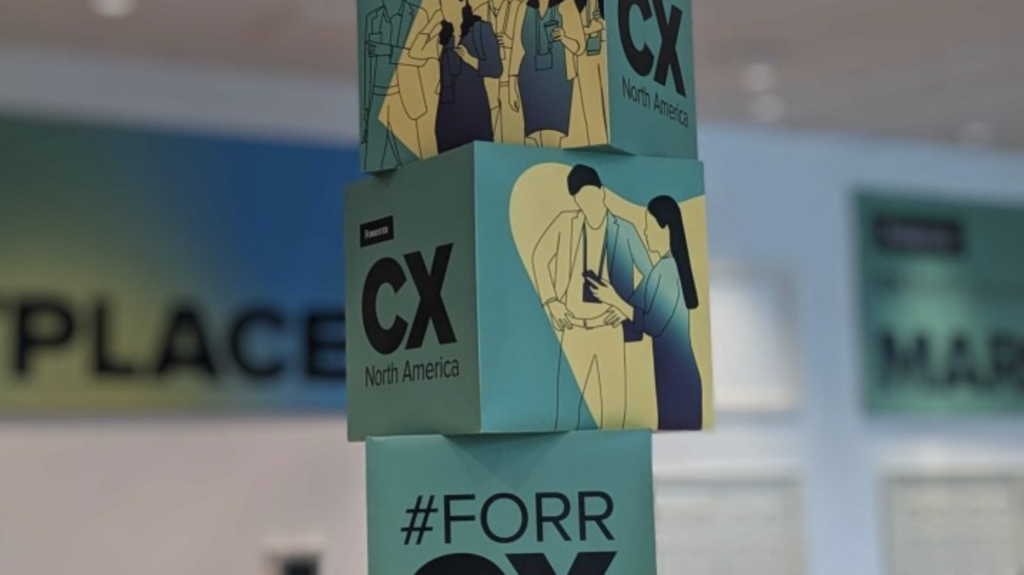
I was fortunate to attend Forrester CX NA recently. It was the first time I traveled for work since the pandemic. And while I’m a decades-old Forrester fan, it was my first time attending their conference.
Chatting with the Forrester analysts and learning about their research was amazing. You know that feeling when you click with someone you just met over a topic you’re both obsessed with? That adrenaline boost you get when you know you’re both dialed in and could talk about it for hours? It was like that throughout the conference. I can’t say enough good things about the hospitality of the hosts and the expertise of the analysts, speakers, and attendees.
But there are a few topics I am still thinking about. You should be thinking about them, too.
1. AI is dominating conversations – and for good reason.
These days, it’s hard “not” to hear about AI. And that was the case at the conference. In a bold keynote speech by Forrester CEO George Colony, he shared that Forrester doesn’t typically promote new technology until they’ve had some time to see it used successfully, witness some mistakes, and observe competition coming online so that they have a complete viewpoint. Colony shared that he was breaking that precedent regarding generative AI and encouraged brands to act immediately. He shared that this may be the end of Google, websites, and paid advertising as we know them. He shared that brands that don’t act now will fall behind and that it’s critical that organizations devote time and resources to developing their AI strategy and execution capabilities. And while I think he took a, perhaps, provocative approach regarding the scale and impact, you can’t deny that AI is a game changer.
I remember personalization being THE game changer, and it took years and years to become a reality. The technology was there, but it took time for the adoption, team skillsets, and consumer demand for personalization to become part of daily corporate life. When AI was first discussed, I wondered if that “hurry up and wait” situation could similarly happen with AI? Since then, I’ve answered my own question and truly believe AI is different. AI is happening now. The barrier to entry is significantly lower and the use cases far broader, allowing it to spread like wildfire.
Any team member can hop on ChatGPT and begin using it. In fact, you probably have team members using it to support their work today. They may use it to inspire content, write code, generate ideas, do competitive research, etc. And unlike personalization, there is no contract or procurement red tape either. It’s available to everyone now. For these reasons, AI will follow a different trajectory than personalization did and we’ll see quicker, yet perhaps more haphazard, adoption of it in daily life.
So, what does this mean for you and me?
As brands determine how to bring generative AI to the forefront for their customers, we must not forget about the impact it will have on internal teams. The ways teams adopt AI will surely impact their day-to-day interactions and have the potential to cause significant disruptions (alongside the innovations). Change management is, and will continue to be, critical. In my daily work, I plan to be vigilant about the people, process, and governance challenges and support building best practices specific to onboarding and leveraging AI. You should keep this top of mind, too.
2. Quantifying CX ROI is still a real challenge.
CX experts want to do the right things for their customers. They want to do smart, interesting, innovative projects that they believe will improve CX. However, it often comes down to a conversation across the table from their CFO. And while CFOs may also share their desire to do right by customers, their role necessitates sufficient proof that the investment will result in monetary benefit to the organization.
The truth is it can be difficult to quantify the ROI of improved CX. What is the monetary value of improving Net Promoter Score (NPS) or Customer Effort Score (CES)? Or, how much will the insights gleaned from a customer research study impact the bottom line? It’s tricky, right? It’s not as straightforward as other digital metrics like Revenue per Visitor or Average Order Value that we rely on for experimentation. And while experimentation ROI is built on the solid footing of incremental annualized revenue that finance teams have come to trust, many qualitative CX metrics aren’t there yet. As a result, leaders are thinking creatively and working to bridge divides across data sets so they can uncover and share a more quantitatively-based narrative. We know the value is there, and it matters, but how can we put a number on it when that’s asked of us?
What does this mean for you and me?
I am continuing to work with our brilliant team at Brooks Bell to look at different ways to bring this to life, and we have some tips to help you get started today.
First, if you can quantify the impact – calculate it, share it, repeat it. Those A/B test lifts you uncovered that improved Revenue Per Visitor? That disastrous decision your customer research study helped to avoid? The process efficiencies you implemented that enable you to achieve more with the same headcount? Those are quantifiable, undeniable returns. Share them up and across your organization.
Not everything is quite as straightforward and quantifiable, though. And if you find that you’re struggling to find that type of data, I encourage you to zoom out to see the bigger picture. Align with your leaders on your company goals, work with them to prioritize them, and agree upon what activities you will be doing to support them. Establish the belief that the activities you agreed upon support those high-level goals. And as you make progress, share that up and across your organization. In this case, you’ll do less calculating of the individual activities because you’re aligned at a higher level. However, make it a goal to track how your findings impacted metrics further down the line so that you can tie those back in quantitatively. This will likely require working more closely with other teams and asking lots of questions to help define how your work is enabling them, and what value they have (or can) attribute to it.
3. Conferences are different post-pandemic.
As I mentioned, this was my first post-pandemic work travel. Many of our clients had travel restrictions and the conference scene has been hit or miss, so it was exciting to get back into it. Like many post-pandemic things, it was different. And it wasn’t due to masks or sanitizer stations, but because we’re all a little different on the other side of the pandemic.
In the past, I was used to a buzzing office M-F, 9 am-5 pm with many trips to see clients, deliver trainings, and lead workshops. I am a little shy, so I was always a little nervous beforehand but would find my stride. Fast forward just 3 years, but that feels like a lifetime ago! I am not as used to being around many people all at once or standing in the spotlight. It can be somewhat overwhelming and exhausting. And I don’t think I am the only one that feels that way!
I noticed more people finding a quiet workplace rather than networking, grabbing a meal from a local restaurant over the conference-provided meal, and steering clear of making eye contact at the sponsor booths. I get it. The pandemic may have helped some of us retreat into our bubbles even further. And as a result, gathering together isn’t quite the same.
This has me wondering… What will the future of conferences be? Virtual conferences feel like dawn-to-dusk webinars, and I rarely (if ever) hear good reviews. So that’s likely not the answer. But large conferences with thousands of people may be a little much in this post-pandemic world. I predict smaller, intimate gatherings that enable 1:1 conversations and less obligatory mingling will be preferred and likely lead to the most meaningful connections.
What does that mean for you and me?
We should encourage each other to get out of our comfort bubbles to build our networks and learn from each other. Let me know if you’d like to join our Click Community on LinkedIn. That’s one place we’re hoping to facilitate a sense of community and a culture of sharing. Let’s talk about what networking formats would best enable that in our world today. Hit the conference scenes, see what you like/don’t, and share your thoughts. There’s no user manual for what they should look like now, so let’s make our own!
Categories
Tags













